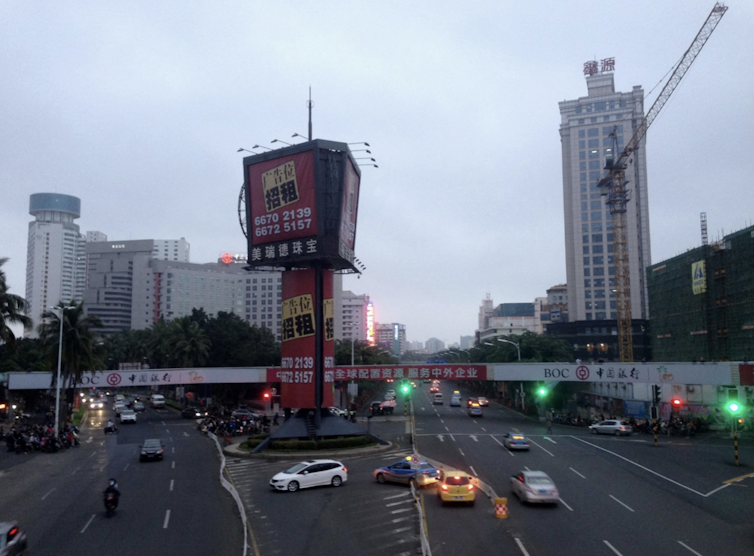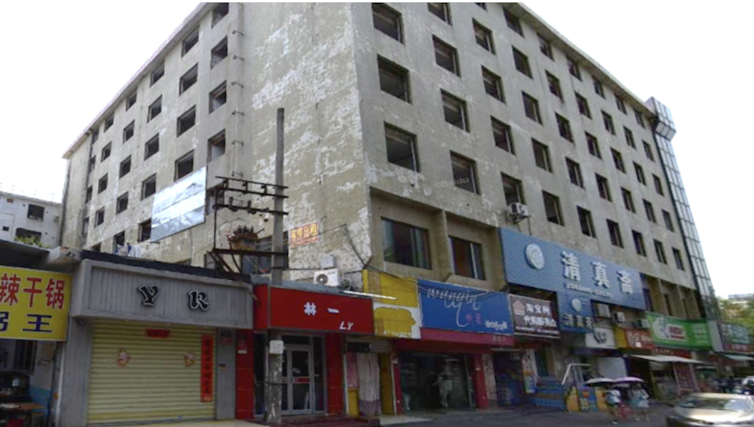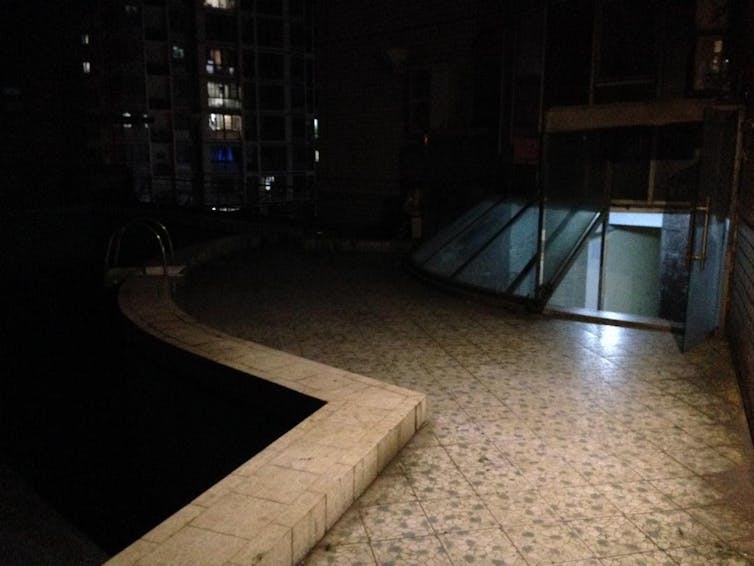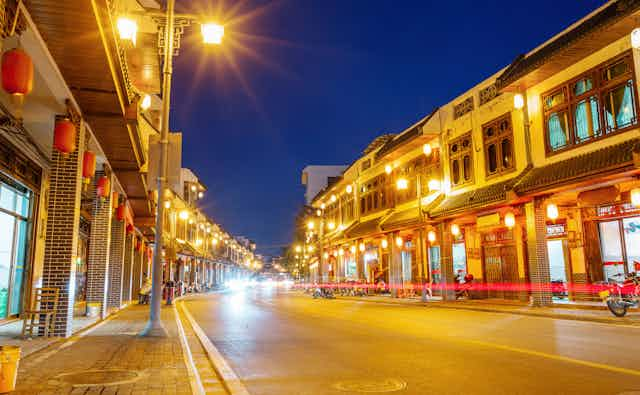It’s around 7:30pm on a warm November evening in Jiaji, the county capital of Qionghai, on the east coast of Hainan, an island province of the People’s Republic of China. I’m standing in a park watching middle aged women dance in formation to music blaring from a loudspeaker when a voice from behind me shouts: “Ah Kang! Let’s go! I’ll take you to see the place where the gays go to play mahjong.”
I turn around to find Ah Tao* hurrying towards me, scrambling over a low hedge. With a population of about 198,000 Jiaji is a small city. I’m here to take a tour of its gay scene and 29-year-old Ah Tao is my guide.
The past 20 years have seen increasing research interest in issues of gender and sexuality in China. This work has explored how, under Maoist socialism (and especially during the fraught years of the Cultural Revolution) “acceptable” modes of gender and sexuality were largely confined to reproductive, cisgender, and heterosexual coupledom.
Following Mao’s death in 1976, China’s transition into a market economy, its reconnection with global capitalism and the arrival of the internet have combined to create opportunities for a greater diversity of gender and sexual identities and lives – though these remain subject to state regulation in the form of media censorship and limitations of the activities of feminist and LGBTQ+ activists.

This article is part of Conversation Insights
The Insights team generates long-form journalism derived from interdisciplinary research. The team is working with academics from different backgrounds who have been engaged in projects aimed at tackling societal and scientific challenges.
There has been some excellent research into the emergence of gay and lesbian identities in China, including how these have been shaped by euro-American ideas of “gay sensibility” and characterised by “individuality, difference, sophistication, liberation and modernity”. One 2018 study detailed gay bars in Shanghai that rivalled those of any western capital, the organisation of “pride” events and the tense contexts in which “queer” film festivals and wider cultural production and activism occur in the face of continued regulation by the authoritarian state.
But this rich and vigorous research has focused overwhelmingly on China’s biggest, most affluent and most globally connected cities – namely Beijing, Shanghai and Guangzhou. When I began my own research, I wanted to see what was happening in China’s marginal provinces and smaller cities.
Back in 2009-10, I spent 12 months studying Mandarin Chinese in Hainan and made friends in local gay communities. Inspired by those experiences, for the past eight years, I have been carrying out research with gay men in the region and, in 2018, completed a PhD thesis exploring gay lives in Hainan. I wanted to find out how gay lives are lived on the margins of global LGBT politics and activism, away from cities imagined as cosmopolitan centres of modernity.
Hainan lies in the Gulf of Tonkin, 30km off the southern coast of mainland China. The region has historically sat on the fringes of the nation, long imagined as an isolated, tropical wasteland of little economic or cultural value.

Recent efforts to repackage Hainan as a high-end tourist destination have raised the island’s national profile. But Hainan has not seen rapid industrialisation, extreme urbanisation and international investment to the same degrees as other coastal regions of China.
My research explores how gay men in Hainan understand themselves, build communities and negotiate the pressures to conform to the heterosexual life script of marriage and reproduction. I looked into how gay lives are figured out in everyday interactions, how they are shaped by the spaces in which they unfold and how this plays out over time.
Hidden gay spaces
Back in Qionghai, Ah Tao and I head north out of the park and through the empty stalls of a market, before turning into a dark alley, wide enough at ground level to traverse on foot, bicycle or moped. But from the second floor up, the buildings jut out on both sides, leaving only a grey-purple strip of darkening sky above the smell of cooking oil descending from extractor fans.
“When we get there, don’t say any gay stuff,” Ah Tao warns me as we approach a shop in the cut-out corner of a building at an intersection with an even narrower alley.
When I first became involved in gay communities in Hainan back in 2009, I was taken by friends to the sole gay bar in Haikou, the provincial capital. I was struck by its location behind an inconspicuous door on the landing of a disused hotel, less than 50 metres from one of the city’s main roads. It was hidden from general view by a larger (and still in-use) hotel. I later learned that these competing dynamics of centrality and obscurity are characteristic of gay spaces in Hainan.

In the island’s biggest cities, Haikou and Sanya, there are gay bars and established cruising areas in certain parks, centrally located yet invariably beyond the view of the wider public.
Haikou’s current gay bar is accessed by climbing through a window on the fifth floor of an ageing tower block, out onto a balcony, past a long dried-up swimming pool and down a rusting staircase. In Sanya, the well trodden pathways that criss-cross a bamboo grove where the edge of a park meets a riverbank are a busy gay meeting spot, while the city’s gay bar, during the time of my fieldwork, was again located in a disused hotel.

To anyone not familiar with gay networks in these cities, these places are invisible and often impossible to find. But for those who know where to look – and who come to frequent these spaces regularly – they are vital sites for the construction of affirmative sexual identities and communities. As Xiaomai, a 19-year-old gay man in Sanya, put it:
When I’m feeling down, or if I’m in a really good mood, I go there to relax, go there to have fun. This is something that makes me happy … If the park didn’t exist, or the club, then people like us would be spread out all over the place, without a gathering place. Because there really aren’t that many of us gays … It’s good that we have these kinds of places.
Outside of the island’s main cities, gay spaces take a different form. There are no gay bars or dark corners of parks used exclusively by gay men (or at least I have never found such places). Instead, in Hainan’s smaller cities and towns, gay men meet in teahouses, convenience stores and park spaces shared with other visitors. In these spaces, fears of being “outed” and the possible damage this could do to family and professional relationships, mean that, as I was warned by Ah Tao, it is best not to “say any gay stuff”.
The floor of the small convenience store at the intersection of two dark and narrow alleys in Jiaji had been cleared to make room for three electric mahjong tables. Around one table, sit four women; around another, four men; and around the last, three women and one man. Ah Tao skirts round the tables and stops to rest his elbows on one of the men’s shoulders.
“Dee la! Not your lucky night!” he laughs, as he looks down at the man’s mahjong pieces. “You’ve not been down here for a while,” says one of the women without raising her eyes from the line of ivory and green rectangles in front her. “I’ve been busy,” Ah Tao answers. “Busy doing what? You’ve no wife, no children,” the woman replies. “Nobody wants him,” chimes one of the men. “How about you introduce someone to me?” Ah Tao retorts as he skirts back around the tables. Standing by my side, he nudges me with his elbow and whispers in my ear: “All the men here are gay.”

Careful regulation of the language and knowledge that is allowed to circulate in these spaces ensures that gay men are only visible as gay men to one another. Non-metropolitan gay spaces in Hainan are therefore characterised by duality – they are both gay and straight spaces. These two aspects are held in separation and much work goes into ensuring that this separation does not collapse.
Spending time in these spaces is a vital way in which gay men experience forms of collective belonging. Yet, the time spent in these spaces is marked by anxieties that, at any moment, cracks might appear in the barrier between parallel gay and straight worlds.
In distinct ways, gay spaces in Hainan’s cities and towns are characterised by juxtapositions of visibility and invisibility, centrality and marginality, presence and absence. In Haikou and Sanya, gay men are occupying spaces in the heart of these cities. But they do so behind inconspicuous doors, in disused buildings and under the cover of darkness, hidden from potentially stigmatising public view.
So too in Hainan’s towns. Here gay men meet one another in plain sight, but their visibility as gay men is carefully managed. They are both present and absent in public space.
Gay spaces in Hainan are a physical manifestation of the communities, identities and lives they sustain. Such patterns of juxtaposition and duality speak volumes about the possibilities for living gay lives.
Concealed from the heterosexual worlds of family, work and general public life, gay lives, identities and communities are joyous and affirming. Yet, there is little desire among gay men for public visibility and little interest overall in living gay lives beyond these hidden worlds.
Social pressure and fear
Still standing in that convenience store in Jiaji, a gay meeting place invisible in plain sight, Ah Tao has just told me that all the men here are gay. I lean in and whisper back, “really? Do the others know?” Ah Tao begins to reply, “no they …”, but he is cut short by one of the women. “Why don’t you have your foreign friend introduce a western girl to you”? she asks, intended less as a genuine question than as an interruption to our whispering. Sensing her suspicion, Ah Tao says his goodbyes and we move on with our tour of the Jiaji gay scene, visiting a teahouse before returning to the park.
Just as gay spaces in Hainan exist as cracks in an otherwise heterosexual public sphere, so too does the time that gay men dedicate to socialising in gay communities. This time is conceived as time apart from the “normal” ordering of lives towards marriage and reproduction. But this time is still threatened by pervasive pressures to marry and have children.
Such pressures come most forcefully from families and within the workplace. But they are also a constant presence in everyday life, interrupting moments of gay life – like the mundane and aggressive reminder Ah Tao received that he had “no wife, no children”.
In the face of such pressures, many gay men in Hainan take much pleasure from their social and sexual relationships with other men and their senses of belonging to gay communities. But they often fear that these ways of living are unsustainable and that they must eventually leave the gay world and conform to their families and the wider society’s expectations that they marry and have children.
Gay communities can provide rich resources for living in the present, but they provide little in terms of orientations towards the future. As Xiaomai told me:
The things that make me happy are the gay friends that I’ve made … we have a lot to talk about and we belong to the same scene, we’re all homosexuals. There are also some things that I find difficult, like, in the future how should I face my family? When I’m in my 20s and I’m still not married, what should I do? What should I do if they force me to marry?
The intensity of these pressures is rooted in Confucian understandings of family – the notion of “the family line” and the importance of its continuity. Ensuring the continuity of the family line is generally considered the specific responsibility of sons and is therefore an acute pressure for gay men. The imagination of alternative life courses to marriage and reproduction in China is also hampered by the government’s censorship of the media, which continues to limit mainstream representations of gender and sexual diversity.
On top of these issues, in recent years, the Chinese government has gone to considerable effort to figure elder care as a private, family matter, rather than a public responsibility and has introduced legislation on children’s duties to care for their elderly parents. This has further entrenched the role of children as necessary carers for their ageing parents and gay men’s perceptions of their futures as oriented towards marriage and reproduction are wrapped up in concerns for self-preservation. As 24-year-old Liang Zongwei from Haikou explained to me:
Do you know why I want to get married? One part of it is because of my parents, but it’s also because I’m afraid. I’m afraid of getting old. What would I do when I get old? Who’s going to look after me then? There is going to come a day when I can’t look after myself anymore. I can’t rely on the Chinese government to care for me in old age.
But I did meet some men who were making plans for alternative life courses. Ah Long, a 36-year-old factory owner from Nada in the north-east of Hainan, was saving up to have a child via surrogacy. He had plans to contract a surrogate mother in Thailand. Then there was 45-year-old Lu Ge, who was investing in property in Sanya so he would have something to fall back on in later life.
However, such strategies for procuring alternative futures to heterosexual marriage and reproduction require substantial financial resources. This places them beyond the reach of all but the most privileged men, especially in an economically marginal region such as Hainan. For many gay men in Hainan, heterosexual marriage and reproduction remain the only practical life courses.
Unliveable lives
It’s now 9pm in Jiaji, the air has cooled and the park is busy. Ah Tao and I make our way over to a sculpture surrounded by a low wall on which three men are sitting. “This is also a meeting place,” Ah Tao informs me. The sculpture is of a plump bronze baby suspended in a looped silver wave. It’s accompanying plaque reads: “Population, Development, Future.” One of the men is topless and is holding in his arms a young child. I later learned that this was his son.
Ah Tao strokes the topless man’s chest and jokes: “What big muscles you have.” The man recoils and looks around to check that no one saw. This is where the tour ends. We spend the rest of the evening enjoying Ah Tao’s stories of his life in the scene, all under the watchful eye of that plump bronze baby.
Very few gay men in Hainan seek to actively contest the limitations placed upon their lives. The intense social stigma that is attached to deviations from heterosexuality means that public visibility as gay is undesirable, especially in smaller cities and towns where bumping into an aunt, uncle or co-worker is a constant concern.
And some men see their plans to marry and have children as a logical repayment of the debt they owe their parents for having raised them. Others see no viable alternatives to marriage and reproduction and so reluctantly accept their inevitability.
In China’s larger cities, community organisations and activists have begun making demands for the legitimisation and public recognition of lives outside of heterosexuality. They are also taking legal action against continued definitions of homosexuality as a mental disorder.
Organised activism has arrived in Hainan too, with the establishment of a regional branch of the Parents and Friends of Lesbians and Gays China in 2016. Their activities have so far been low key, focusing on community building and knowledge sharing. But this may signal at least some interest in challenging the status quo and the potential for future changes to gay lives in Hainan through greater public visibility and engagement with activism.
Whatever forms sexual politics and activism take in Hainan, close attention should be paid to the concerns and desires of gay men, lesbians and other marginalised gender and sexual groups. Strategies for resistance should respond to the cultural and material realities of their lives.
It may sound over the top but as I reflect on my time with Ah Tao – and all I have learned from gay men in Hainan – I find myself contemplating the meaning of life. Or at least the meaning of “a life”. What is a life and how are some lives made more liveable than others?
The experiences of gay men in Hainan show how lives are shaped by the spaces and times that are available for living in particular ways. These men are claiming spaces, forging identities and building communities. These provide the basis for living lives outside of the institutions of family, education and work that otherwise make up the social scenes of everyday life and tend to powerfully enforce heterosexuality.
The spaces and times of gay lives, however, are limited. These are lives lived beneath the surface of a heterosexual public sphere and they are largely confined to the present.
- All names and some details have been changed to protect the anonymity of those involved and the places described.

For you: more from our Insights series:
To hear about new Insights articles, join the hundreds of thousands of people who value The Conversation’s evidence-based news. Subscribe to our newsletter.

